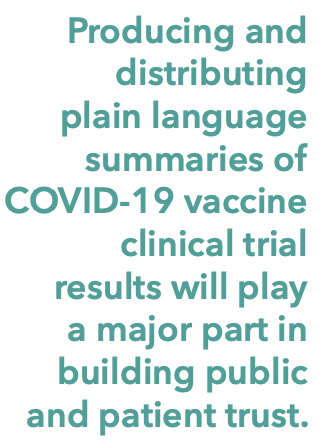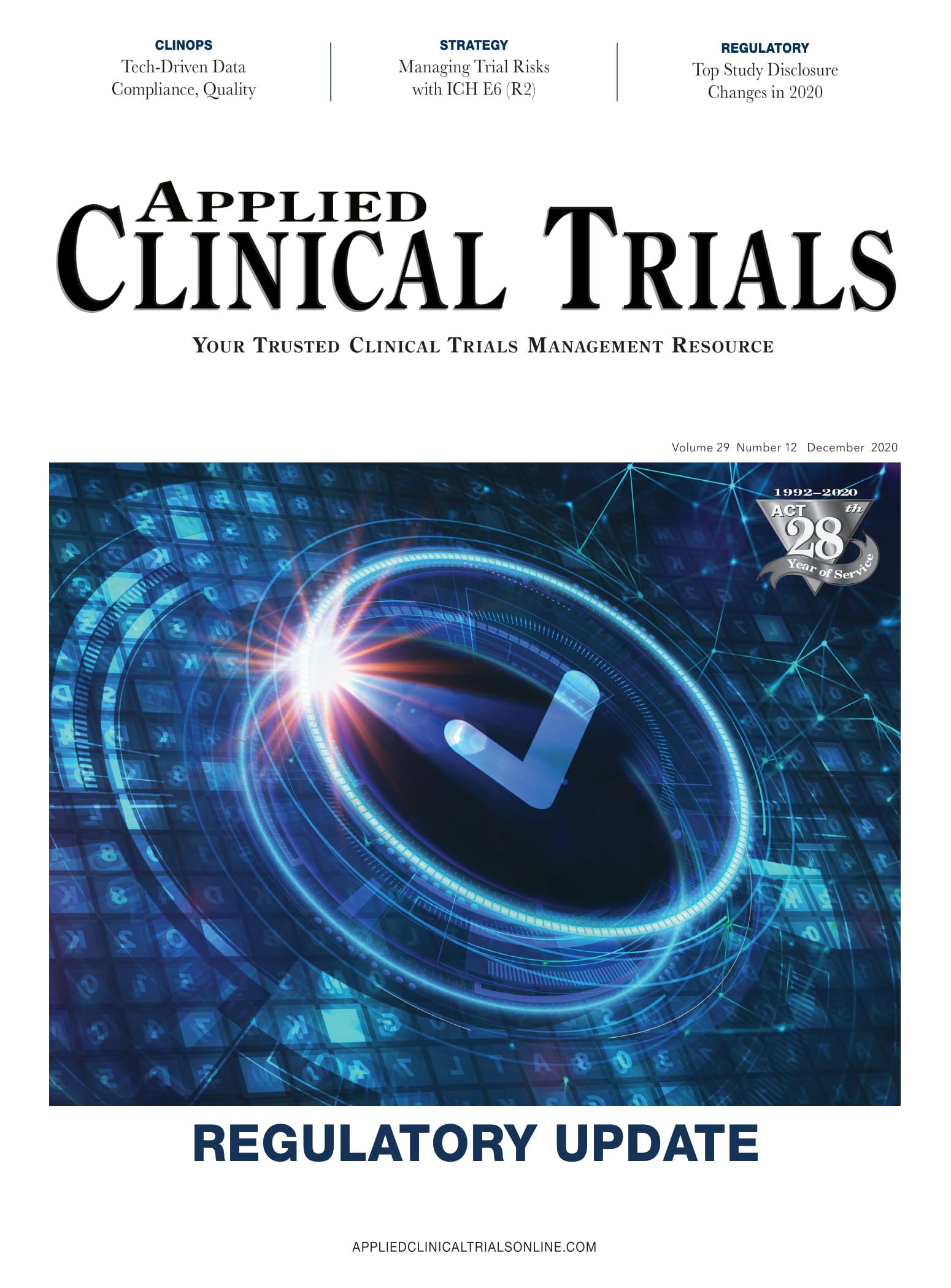Public Trust and the ‘Last Mile’ for COVID-19 Vaccines
Battle for trust ensues as vaccines are set for approval.
Ken Getz

Throughout the pandemic, the global public has had a front-row seat in an emotional theater of drug development. Daily news updates and more in-depth profiles have covered scientific breakthroughs, new collaborations, commitments, clinical trial activity, and preliminary results from interim assessments. And, as a result, public awareness of the role and importance of the pharmaceutical industry has increased sharply and public perception has improved dramatically.
This is a unique moment and a rare opportunity for drug development stakeholders to hit the reset button and enter a higher level of partnership and engagement with the public and patient communities. But until now, the pharmaceutical industry has largely emphasized one side of the story. The focus-to-date has been inward—on the industry’s innovativeness, productivity, passion, and commitment.
With late-stage vaccinations in the process of receiving Emergency Use Authorizations (EUA), the clinical research community—in collaboration with public health officials and the clinical care community—needs to expand its focus outward to collectively engender trust and support for the great science that the world is witnessing.
In addition to conveying gratitude for study volunteers who participated in COVID-19 vaccine and treatment clinical trials, the clinical research enterprise must also demonstrate respect for the public and patients through complete transparency and disclosure, in plain language, of the results of its COVID-19 clinical trials; and it must provide consistent and easy-to-understand patient and public education focusing on the “last mile” between the availability of safe and effective new vaccines and the societal importance of, and obligation in, their uptake.
Reputation rebirth
As early as this past April, Pew Research reported growing public support for the pharmaceutical industry. This could not have come any sooner. Only eight months earlier (September 2019), Pew Research reported that the pharmaceutical industry was the most poorly regarded of all industries, having finally received the lowest rating of all those evaluated. Many may recall a Pew Research study published several years ago showing that the pharmaceutical industry’s reputation had fallen sharply putting it on par with the oil and used car industries.
In July 2020, the Harris Poll conducted among several thousand Americans noted that 54% gave the pharmaceutical industry positive ratings. This was a remarkable 22 percentage point increase above the results that Harris had reported in February 2020, one month before widespread lockdowns went into effect. Harris noted in its report that pharmaceutical companies were “… the only industry to sustain reputation gains through the pandemic. While other industries—such as grocery, retail, technology, consumer products and financial services—also rose during the spring and summer, most spiked in May and have since flattened or dropped back to typical pre-COVID levels.”
And a global poll conducted by Caliber Research in September 2020 reported that public perceptions of the pharmaceutical industry had improved measurably around the world. The poll solicited responses from more than 13,000 people. Caliber noted that “COVID-19 is playing a very important role in reminding people of the [pharmaceutical industry’s] importance and relevance, especially in markets like the U.S. where the pandemic’s positive reputational impact has so far been the greatest.”
Progress without clarity
Between April and October 2020, news coverage of coronavirus drug development activity appeared several times per week. Beginning in early November, however, daily coverage became the norm as preliminary results of late-stage COVID-19 vaccine trials, funded by Operation Warp Speed, were publicized. Pfizer-BioNTech was the fist to announce in early November followed by Moderna in mid-November and AstraZeneca-Oxford University later in the month. In December, regulatory agencies including the FDA’s Center for Biologics Evaluation and Research (CBER) will begin making decisions with regards to EUAs. Through the Operation Warp Speed program, drug and biologic development will be more than 80% faster than the typical clinical duration for vaccines.
A number of nongovernmental committees and panels are providing input and expertise to inform emergency access and approval, as well as vaccine distribution and logistics decisions. These committees include the Vaccines and Related Biological Products Advisory Committee (VRBPAC), which provides input into EUAs and approvals of vaccines. The Center for Disease Control’s (CDC) Advisory Committee on Immunization Practices (ACIP) provides input into the distribution of vaccines and their use. In partnership with these committees, CBER and the CDC have far greater public transparency.
Collectively, these agencies and committees now face the difficult task of facilitating unprecedented development and commercialization speed while reassuring the public that no corners have been cut and that these treatments and vaccines are in the most competent and capable hands.
Operation Warp Speed leadership has yet to clearly indicate publicly how COVID-19 vaccines will be allocated. And although ACIP, the CDC, the National Academies, and outside consultants have all been meeting to discuss prioritization of COVID-19 vaccines when they are available, lack of clarity and simple messaging tailored to the lay community has contributed to speculation in the media and ultimately public confusion and concern. At the outset of the pandemic, public confusion and concern began mounting—and has not abated—with the poor availability and apparent mismanaged distribution of personal protective equipment and the antiviral medication remdesivir.
Transparency and trust
The majority of the public worldwide supports vaccines. But a vocal minority—very often without rational or scientific basis—is against vaccination. Concerns over a link between vaccines and autism, for example, persist despite scientific evidence to support it. Public confidence in vaccines varies by country and by communities within a given country.
The media tends to exacerbate the problem. They report adverse patient conditions and/or patient deaths associated with the time of a vaccination, but not the results of investigations into the cause of death. These investigations, completed long after misinformation has been in circulation, typically show that the condition and/or death was unrelated to the vaccine.
For COVID-19 vaccines to be widely embraced and to deliver on their promise, they must engender public confidence and trust. Clinical research and healthcare professionals must ensure that their messages about vaccines and their distribution are balanced and transparent in depicting risks, benefits, and uncertainties. Messages must also be customized to the community that they target. Plain, non-technical, tailored communications in the mass and social media will go far in helping to build this balance and transparency. Consistent and simple—but not oversimplified—communication is essential. Creative communications developed by a collective of major advertising agencies will be highly valuable input here.
Media briefings will also prove helpful as many reporters have little to no background in medical research and healthcare. Partnerships with patient advocacy groups will also help ensure that communications reach a broader community via sources that are perceived as trusted and credible.

Producing and distributing plain language summaries of COVID-19 vaccine clinical trial results will also play a major part in building public and patient trust. At this time, the pharmaceutical companies leading Operation Warp Speed late-stage vaccine trials have signaled their primary intent to publish the results of their clinical trials in medical journals and on the NIH ClinicalTrials.gov registry. But this is not enough. These channels are primarily geared toward the scientific and medical community. Plain language summaries should be disseminated—simultaneously with the publication of technical summaries—to patients who participated in the clinical trials through public-facing healthcare communication channels, patient advocacy groups, mass media outlets, and digital and social media.
Despite unprecedented investments in vaccine development and distribution, public confidence in COVID-19 vaccines is hopeful but tenuous. This is due in large part to historical context, the lack of clarity and transparency from government agencies and the clinical research and healthcare professional communities. It is also due to the spread of misinformation since the pandemic began.
Global vaccination programs that rid the world of COVID-19 will succeed only if there is widespread belief and trust that these vaccines are safe and effective, that policies for prioritizing and executing their distribution are equitable and rational, that every individual has an important part to play. Translating the scientific progress and promising new vaccines into successful vaccination programs will require overcoming the significant challenge of building public trust and confidence through frequent, comprehensive, consistent, customized, balanced, and straightforward communication and education.
Ken Getz, MBA, Deputy Director and Research Professor, Tufts CSDD; Chairman of CISCRP. Reach Ken Getz via email at kenneth.getz@tufts.edu
